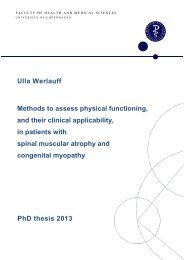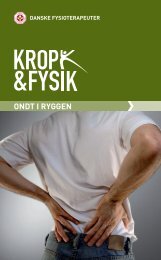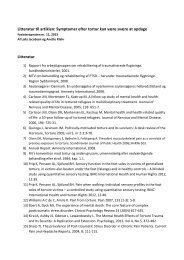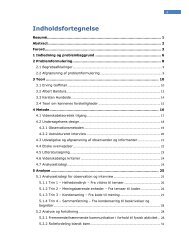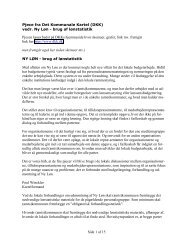Kristian Thorborg's Phd Thesis
Kristian Thorborg's Phd Thesis
Kristian Thorborg's Phd Thesis
You also want an ePaper? Increase the reach of your titles
YUMPU automatically turns print PDFs into web optimized ePapers that Google loves.
The groin is anatomically located in the anterior-medial part of the hip region, and the hip and<br />
groin region share vascular and neural supply.[112] The pathologies of the hip joint and the groin<br />
often present simultaneously and the symptoms can be overlapping.[31-34] This makes the hip<br />
and groin a complex anatomical region where validated diagnostic tools for differentiation of<br />
musculoskeletal diagnoses are lacking.[35-38] We therefore chose not to restrict our<br />
measurement instrument to be evaluated in a patient group with a specific diagnosis, but instead<br />
we wanted to focus on the commonalities of hip and/groin pain in physically active patients.<br />
The patient flow is presented in Figure 11. Patients from primary and secondary care, who were at<br />
least 18 years of age, were screened by a specialist within the area of musculoskeletal examination<br />
of hip and/or groin pain in younger physically active patients. If the specialist suspected that hip<br />
and/groin pain was not of musculoskeletal origin, the patient was referred for further<br />
investigation and was not invited to participate in the study. All other patients presenting with hip<br />
and/or groin pain were considered eligible for the study, and were invited to participate. These<br />
patients were informed about the purpose of the research by the people responsible for the<br />
study, and written consent was obtained from those who agreed to participate. A self-reported<br />
questionnaire was used to screen for inclusion and exclusion of the patients who agreed to<br />
participate in the study. Patients seeking medical care presenting with hip and/or groin pain were<br />
included if they fulfilled all the following criteria; 1) had received treatment for their hip and/or<br />
groin pain 2) were restricted in their activities due to hip and/or groin pain 3) had hip and/or groin<br />
pain in the previous 14 days 4) had hip and/or groin pain of more than 6 weeks’ duration 5) had<br />
hip and/or groin pain located in one of five predefined regions in a pain drawing (region 3,6,7,8 or<br />
9, Figure 12), and 6) were physically active for more than 2.5 hours per week. Patients with self-<br />
reported limiting co-morbidities[113] were excluded from the study. The pain drawing (Figure 12)<br />
was adapted from methods for determining location of pain used in previous studies,[30,114] and<br />
pain of more than 6 weeks’ duration has previously been defined as longstanding in nature<br />
concerning the population under study.[3]<br />
31



